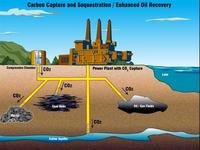-
Petroleum industry, railroads want deadline extension for phasing out old tank cars

Transportation of crude oil by train jumped to 408,000 in 2013, from 11,000 in 2009, partly due to the rise in production from North Dakota’s Bakken region, where oil production has surpassed pipeline capacity. The increasing use of rail to transport crude oil has resulted in several accidents. The Department of Transportation want to phase out older tank cars — because they have thinner shells and are thus more vulnerable to accidents when transporting flammable liquids like crude oil – and replace them with new, safer tank cars with thicker shells. The petroleum industry and U.S. railroads want DOT to extend the deadline for phasing out old tankers from two years to four years.
-
-
More stringent climate policies mean hard choices for coal plant operators
Limiting climate change to 2°C means shutting down coal power plants — an unpopular proposition for coal power companies. A new study shows, however, that delaying climate policies could prove even worse for power plant owners. The reason: new power plants being built now, especially in China and India, are built to run for 30-50 years, paying off only after years of operation. Stringent climate policies, however, could make the cost of emission so high that coal power generation is no longer competitive, leaving new power plants sitting idle and their owners and investors with huge losses — a problem known as stranded capacity.
-
-
Controversial Mississippi power station to cut emissions by more than half

A new $5 billion state-of-the-art power facility is under construction Kemper County, Mississippi. It places a firm bet on the future of carbon-capture technology, and other technological advancements, including: it utilizes the gasification process with carbon in unique ways; it recycles treated wastewater to generate power; and it makes money from the carbon dioxide it has removed by selling it to oil companies for their own extraction. Critics say that investing so much money in untested technologies is too much of a gamble.
-
-
Small biomass power plants could help rural economies, stabilize national power grid

As energy costs rise, more Americans are turning to bioenergy to provide power to their homes and workplaces. Bioenergy is renewable energy made from organic sources, such as biomass. Technology has advanced enough that biomass power plants small enough to fit on a farm can be built at relatively low costs. Researchers have found that creating a bioenergy grid with these small plants could benefit people in rural areas of the country as well as provide relief to an overworked national power grid.
-
-
Advancing algae’s viability as a biofuel
Lab success does not always translate to real-world success. A team of scientists, however, has invented a new technology that increases the odds of helping algae-based biofuels cross that gap and come closer to reality. The current issue of Algal Research showcases the team’s invention — the environmental photobioreactor. The ePBR system is the world’s first standard algae growing platform, one that simulates dynamic natural environments.
-
-
U.K. could generate half its energy needs from currently underutilized bioenergy sources

The United Kingdom could generate almost half its energy needs from biomass sources, including household waste, agricultural residues, and home-grown biofuels by 2050, new research suggests. Scientists found that the United Kingdom could produce up to 44 percent of its energy by these means without the need to import. The new study highlighted the U.K. potential abundance of biomass resources that are currently underutilized and totally overlooked by the bioenergy sector.
-
-
50-state roadmap to renewable energy unveiled
Researchers recently developed detailed plans to transform the energy infrastructure of New York, California, and Washington states from fossil fuels to 100 percent renewable resources by 2050. The new roadmap to renewable energy for all fifty states was presented on 15 February at the annual meeting of the American Association for the Advancement of Science (AAAS) in Chicago. The online interactive roadmap is tailored to maximize the resource potential of each state.
-
-
Promising geothermal resources found on Akutan Island, Alaska
Akutan Island, in Alaska’s east-central Aleutian Islands, hosts the City of Akutan and is home to the largest seafood production facility in North America. It also hosts Akutan Volcano, one of the most active volcanoes in the United States. During July 2012 the geochemistry of the hot springs on Akutan Island was studied in detail for the first time since the early 1980s. The results from this study document higher concentrations of hydrothermal components in the hot spring waters and an increase in water discharge from the hot spring system. The current heat output of the hot spring system is estimated at twenty-nine megawatts — nearly ten times higher than measured in the early 1980s. This large increase may reflect the volcanic and seismic events of the 1990s, and if so, it cannot be considered a short-term anomaly. Modern geothermal plants could use this heat to generate several MW of electricity. One MW of electric power would supply the needs of about 750 homes.
-
-
NSF rapid response research grants to fund study of West Virginia chemical spill
On 9 January 2014, crude 4-methylcyclohexane methanol (MCHM), a chemical primarily used to clean coal, leaked from a storage tank near Charleston, West Virginia, and bled into a river upstream of a water-treatment plant. As a result, about 15 percent of the state’s residents were advised not to drink the water. Better to understand the properties of the chemical that contaminated the drinking water, and the plumbing and water-treatment systems surrounding the area, the National Science Foundation (NSF) has awarded Rapid Response Research (RAPID) grants to research teams at three universities. These grants also will provide STEM learning opportunities for undergraduate and graduate students on the research teams.
-
-
New biofuel sources does not require farmland

While the debate over using crops for fuel continues, scientists are now reporting a new, fast approach to develop biofuel in a way that does not require removing valuable farmland from the food production chain. Their work examines the fuel-producing potential of Streptomyces, a soil bacterium known for making antibiotics.
-
-
The world likely to face more frequent, and more severe, blackouts

U.S. household electricity usage increased by 1,300 percent between 1940 and 2001. In the last few decades, air conditioning has been the greatest factor in increased electrical consumption, and one of the greatest sources of systematic strain, with considerably more blackouts occurring in the summer months than during winter. The electricity used to fuel America’s air conditioning is currently of a similar volume to the U.S. entire energy consumption in the 1950s. A new study reveals that today’s occasional blackouts are dress rehearsals for the future, when they will occur with greater frequency and increased severity. Power cuts will become more regular around the globe as electrical supply becomes increasingly vulnerable and demand for technology continues to grow at an unprecedented rate.
-
-
Traveling by car uses most energy
Fuel economy must improve 57 percent in order for light-duty vehicles to match the current energy efficiency of commercial airline flights, a new research finds. The research examined recent trends in the amount of energy needed to transport a person a given distance in a light-duty vehicle (cars, SUVs, pickups and vans) or on a scheduled airline flight. His analysis measured BTU per person mile from 1970 to 2010.
-
-
Minimizing power grid disruptions from wind power
Researchers have found that an increase in the use of wind power generation can make the power grid more fragile and susceptible to disruptions. The researchers, however, did not just identify the problem — they have also devised a technique for coordinating wind power generation and energy storage in order to minimize the potential for such power disruptions.
-
-
Carbon capture technology vital for meeting climate targets

In 2010, coal, oil, and gas supplied more than 80 percent of the world’s total primary energy supply — and the demand for energy is projected to increase by two to three times by 2100. Studies show that without policies to cut greenhouse gas emissions, fossil fuels will remain the major energy source in 2100, with resulting increases in greenhouse gas emissions. Where should policymakers focus their carbon mitigation efforts, however? Which technologies hold the most promise?Scientists say that a combination of carbon capture and storage (CCS) and bioenergy has advantages over solar, wind, and nuclear because it can lead to negative emissions. Moreover, bioenergy can be converted into liquid and gaseous fuels which are easily storable and can be readily used by current transportation systems,thus taking some pressure off other sector in terms of required mitigation effort.
-
-
How effective are renewable energy subsidies? It depends
Renewable energy subsidies have led to explosive growth in wind power installations across the United States, especially in the Midwest and Texas. Electricity produced by wind is emission free, so the development of wind-power may reduce aggregate pollution by offsetting production from fossil fuel generated electricity production. Emission rates of fossil fuel generators, however, vary greatly by generator (coal-fired, natural gas, nuclear, hydropower). Thus, the quantity of emissions offset by wind power will depend crucially on which generators reduce their output. In other words, the quantity of pollutants offset by wind power depends crucially on which generators reduce production when wind power comes online.
-
- All
- Regional
- Water
- Biometrics
- Borders/Immig
- Business
- Cybersecurity
- Detection
- Disasters
- Government
- Infrastructure
- International
- Public health
- Public Safety
- Communication interoperabillity
- Emergency services
- Emergency medical services
- Fire
- First response
- IEDs
- Law Enforcement
- Law Enforcement Technology
- Military technology
- Nonlethal weapons
- Nuclear weapons
- Personal protection equipment
- Police
- Notification /alert systems
- Situational awareness
- Weapons systems
- Sci-Tech
- Sector Reports
- Surveillance
- Transportation
Advertising & Marketing: advertise@newswirepubs.com
Editorial: editor@newswirepubs.com
General: info@newswirepubs.com
2010-2011 © News Wire Publications, LLC News Wire Publications, LLC
220 Old Country Road | Suite 200 | Mineola | New York | 11501
Permissions and Policies
Editorial: editor@newswirepubs.com
General: info@newswirepubs.com
2010-2011 © News Wire Publications, LLC News Wire Publications, LLC
220 Old Country Road | Suite 200 | Mineola | New York | 11501
Permissions and Policies
